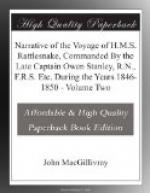Sail upon first northern cruise.
October 11th.
After a protracted stay in Sydney of very nearly three months, we were at length enabled to start upon our first cruise to the northward, the object of which was to make a survey of Port Curtis and part of the Inshore Passage leading up to Torres Strait. The Rattlesnake and tender got under weigh soon after daybreak and ran out of Port Jackson to the northward with a fine South-east wind. In the evening the Bramble parted company, her present destination being Port Stephens, for the purpose of running a meridian distance, and ours Moreton Bay.
One day, while off Cape Byron, an interesting addition to zoology was made in a small floating shellfish, which has since proved to constitute a new genus,* throwing light, I am informed, upon many fossil univalves in the older formations; and a rare bird of the noddy kind (Anous leucocapillus) perched on the rigging towards evening, and was added to the collection; for even the beauty and innocence of a tired wanderer like it was insufficient to save it from the scalpel.
(Footnote. This mollusc, allied to Litiopa, Professor E. Forbes has done me the honour to publish in the Appendix as Macgillivrayia pelagica.)
Arrive at Moreton bay.
On October 18th we anchored in Yule’s Roads, Moreton Bay in 12 fathoms, sand, about a mile off shore, and remained there for sixteen days. During our stay, some additions were made to render more complete the former survey of this important sheet of water. Buoys were laid down to mark the intricate channels of the north entrance, now preferred for its greater safety to the south entrance, although lengthening by about 50 miles the passage to or from Sydney. The wreck of a steamer, and loss of most of those on board, had not long before caused a great sensation, and forcibly attracted attention to the dangers of the southern entrance.
Moreton Bay is an expanse of water 45 miles in length, and 20 in greatest width, enclosed between the mainland and Stradbroke and Moreton Islands. It is open to the northward, but sheltered on the eastward by the two islands forming that side, which run nearly north and south. The Brisbane river enters the bay about the middle of its western side, and, having been the means of opening up an immense extent of the finest pastoral country, it has conferred a considerable degree of importance upon the place as a harbour, although beset with numerous shoals and narrow winding passages, through which the tides run with great force. The entrance to the river has a depth of only 10 or 11 feet at high-water, consequently, is available for small vessels only; the best anchorage for larger ones is five miles distant. The banks are constantly shifting, and the channel is intricate. When to this is added that the settlement—consisting of the townships of North and South Brisbane, and Kangaroo Point, is situated 14 miles from the river mouth—it was not surprising that a proposal had been made to establish a trading port elsewhere in the bay, so that the wool and other produce of the district, might be shipped direct for England.




